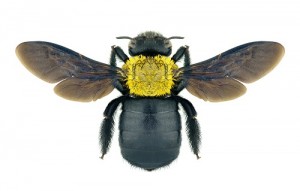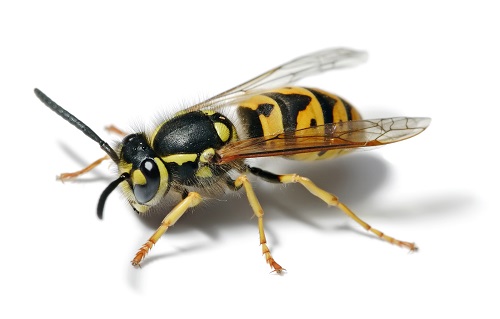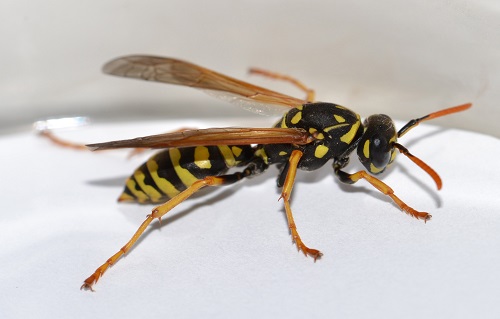Carpenter bees are about 1” in size with shiny mostly black bodies and a small yellow band around their upper body (thorax) by the head. Carpenter bees are often confused for bumble bees, however, lack the large bands of yellow hair around their abdomen. Carpenter bees drill a perfectly round 1/2” entrance hole into wood where they excavate galleries for nesting. They primarily prefer unpainted softwoods for nesting. Nesting sites include house siding, eaves, fascia boards, fences, decks and outdoor furniture. Signs of infestations include heavy carpenter bee activity in a particular area, the accumulation of sawdust in heavily active areas and the presence of yellow to brown excrement stains on surfaces underneath their entrance holes. Male carpenter bees hover and get aggressive when protecting their nesting site, but are harmless because they do not have a stinger. Although the female carpenter bee has a stinger, they rarely sting unless it is handled or molested. Carpenter bees emerge in the spring to reproduce, build a nest and lay eggs before the adults die off.
Carpenter bees are often confused for bumble bees, however, lack the large bands of yellow hair around their abdomen. Carpenter bees drill a perfectly round 1/2” entrance hole into wood where they excavate galleries for nesting. They primarily prefer unpainted softwoods for nesting. Nesting sites include house siding, eaves, fascia boards, fences, decks and outdoor furniture. Signs of infestations include heavy carpenter bee activity in a particular area, the accumulation of sawdust in heavily active areas and the presence of yellow to brown excrement stains on surfaces underneath their entrance holes. Male carpenter bees hover and get aggressive when protecting their nesting site, but are harmless because they do not have a stinger. Although the female carpenter bee has a stinger, they rarely sting unless it is handled or molested. Carpenter bees emerge in the spring to reproduce, build a nest and lay eggs before the adults die off.
 Carpenter bees are often confused for bumble bees, however, lack the large bands of yellow hair around their abdomen. Carpenter bees drill a perfectly round 1/2” entrance hole into wood where they excavate galleries for nesting. They primarily prefer unpainted softwoods for nesting. Nesting sites include house siding, eaves, fascia boards, fences, decks and outdoor furniture. Signs of infestations include heavy carpenter bee activity in a particular area, the accumulation of sawdust in heavily active areas and the presence of yellow to brown excrement stains on surfaces underneath their entrance holes. Male carpenter bees hover and get aggressive when protecting their nesting site, but are harmless because they do not have a stinger. Although the female carpenter bee has a stinger, they rarely sting unless it is handled or molested. Carpenter bees emerge in the spring to reproduce, build a nest and lay eggs before the adults die off.
Carpenter bees are often confused for bumble bees, however, lack the large bands of yellow hair around their abdomen. Carpenter bees drill a perfectly round 1/2” entrance hole into wood where they excavate galleries for nesting. They primarily prefer unpainted softwoods for nesting. Nesting sites include house siding, eaves, fascia boards, fences, decks and outdoor furniture. Signs of infestations include heavy carpenter bee activity in a particular area, the accumulation of sawdust in heavily active areas and the presence of yellow to brown excrement stains on surfaces underneath their entrance holes. Male carpenter bees hover and get aggressive when protecting their nesting site, but are harmless because they do not have a stinger. Although the female carpenter bee has a stinger, they rarely sting unless it is handled or molested. Carpenter bees emerge in the spring to reproduce, build a nest and lay eggs before the adults die off.

